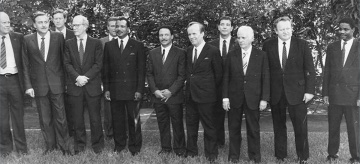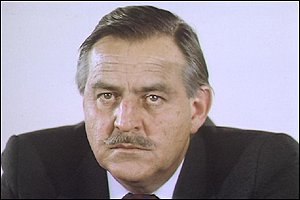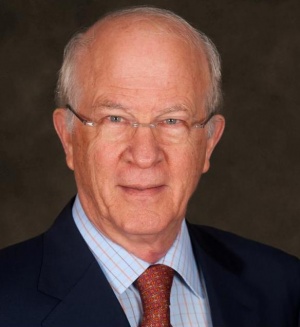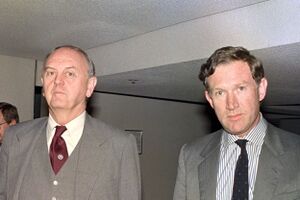New York Accords
 At the preliminary Brazzaville negotiations are (left to right) South African Defence Minister Magnus Malan, Foreign Minister Pik Botha, US Assistant Secretary of State Chester Crocker and (2nd from right) UN Under Secretary-General for Administration Martti Ahtisaari | |
| Type | Treaty |
| Publication date | 22 December 1988 |
| Founded | 1988-12-22 |
| Author(s) | • Angola • Cuba • South Africa |
| Interest of | Roland Darroll |
The New York Accords, signed on 22 December 1988, followed the May 1988 Reagan/Gorbachev summit in Moscow, after which a quick succession of talks took place in London, New York, Geneva, Cairo, and Cape Verde aimed at a negotiated regional peace settlement for Southern Africa.
The Congo's capital Brazzaville hosted the final round of negotiations culminating in a preliminary agreement pursuant to UN Security Council Resolution 435 of 1978 (which called for the withdrawal of South African troops from Namibia). Known as the Brazzaville Protocol, this preliminary agreement also committed Cuba and South Africa to withdraw their troops from Angola, and was initialled on Tuesday 13 December 1988 by representatives of Angola, Cuba and South Africa.[1]
Three participants pictured in Brazzaville would have been expected to attend these negotiations: Magnus Malan, Pik Botha and Chester Crocker. But what on earth was the United Nations corruption scandal-enmeshed Under-Secretary-General for Administration and Management Martti Ahtisaari doing there? Other significant participants in Brazzaville included Congolese President Denis Sassou N’Guesso; Soviet Foreign Minister Eduard Shevardnadze; Jean-Christophe Mitterrand, Special Adviser on Africa to French President François Mitterrand; French not-so-secret agent Jean-Yves Ollivier; and, General Neels van Tonder, South African Defence Force Head of Military Intelligence.[2]
The New York Accords comprising:
- Tripartite Accord (between Angola, Cuba and South Africa), granting independence to Namibia which had been illegally occupied by apartheid South Africa in defiance of UN Security Council Resolution 435; and,
- Bipartite Accord (between Angola and Cuba), providing for the withdrawal of 50,000 Cuban troops from Angola,
were formally signed the following week on Thursday 22 December 1988 at United Nations headquarters in New York.[3]
A notable absentee from the signing ceremony was United Nations Assistant-Secretary-General and UN Commissioner for Namibia Bernt Carlsson, who had been targeted on Pan Am Flight 103 that exploded over Lockerbie in Scotland on Wednesday 21 December 1988, killing all 259 passengers and crew.[4]
Contents
Signing ceremony
UNITED NATIONS, Thursday 22 December 1988. In a ceremony marred by angry exchanges, representatives of Angola, Cuba and South Africa signed two accords here today providing for independence for Namibia and the withdrawal of about 50,000 Cuban troops from Angola. The accords, which were signed in the presence of US Secretary of State George P. Shultz, mark the successful conclusion a long and difficult mediation effort by the United States, with Soviet support, and hold out the promise of an end to decades of conflict in south-western Africa. The accords also mark the end of a decade-long effort by the United Nations to persuade South Africa to give up control over Namibia, also known as South-West Africa. But South Africa yielded only in return for a firm commitment from Cuba to withdraw all its forces from Angola by 1 July 1991.
Harsh words
Nevertheless, the sharp words used today by the Foreign Ministers of Cuba, Angola and South Africa and by George Shultz showed that serious differences remain. Major areas of disagreement are the Reagan Administration's refusal to suspend military aid to the Angolan guerrillas (UNITA) and the failure of the Angolan Government to make peace with its opponents. In a clear reference to American and South African support for the Angolan rebel forces of Jonas Savimbi, Foreign Minister Afonso Van Dunem of Angola called for an end to foreign meddling in Angola's internal affairs. But the Angolan official also called for the restoration of normal relations with the United States, saying that since the two countries must work together to carry out today's agreements, such collaboration could surely be facilitated by the normalisation of diplomatic relations. He added that the accords signed today would promote reconciliation in Angola, and promised a new amnesty law next month to encourage the Angolan guerrillas to lay down their arms.
On Wednesday, however, Chester Crocker, the Assistant Secretary of State for African Affairs and the main architect of the accords, indicated that Washington would continue arming the rebel group, known by its Portuguese acronym UNITA, and reject full diplomatic ties with Angola until it makes peace with its opponents: There can be no military solution, he said.
Foreign Minister Isidoro Malmierca Peoli of Cuba was much sharper than the Angolan official in his criticism of the United States and South Africa, saying their support for the UNITA guerrillas had caused enormous destruction and tens of thousands of deaths.
South African angered
The Cuban official's speech so annoyed Foreign Minister Roelof F. Botha of South Africa that he departed from his prepared remarks to say that he could name many black African presidents who so opposed Cuba's military presence in Angola that they had asked South Africa to stay in Namibia until the last Cuban soldier goes. Pik Botha then proposed to the Cuban Foreign Minister a debate on their countries' human rights records.
Mr Malmierca unsuccessfully sought to reply, shouting, Please, please, Mr. President! But George Shultz, who was chairman of the signing ceremony, dismissed him with a brisk wave of the hand.
In bringing the meeting to a rapid conclusion, Mr Shultz said it was miraculous that this agreement was consummated at all, adding, Much of what has been said here, I do not appreciate and I do not agree with.
In his opening remarks, George Shultz had called the accords a momentous turning point in the history of southern Africa. Like other speakers at the signing ceremony, Mr Shultz prefaced his remarks with words of condolence for relatives and friends of those killed in the plane crash in Scotland on Wednesday. The victims included Bernt Carlsson, the chief administrative officer of the United Nations Council for Namibia, who was returning to New York for today's ceremony.
Under the first agreement, signed by Angola, Cuba and South Africa, the South African Government agrees to surrender control of Namibia and carry out a United Nations plan approved 10 years ago to give independence to the territory. Cuba also agreed to withdraw all its forces from Angola in a stages over 27 months starting 1 April 1989. Finally, the three Governments pledged to respect the principle of non-interference in the internal affairs of the states of south-west Africa. They promise not to allow their territory to be used by any state, organisation or person in connection with any acts of war, aggression or violence against other nations in the region.
The second accord, signed only by Angola and Cuba, provides a detailed timetable for the withdrawal of approximately 50,000 troops which make up the Cuban forces in the People's Republic of Angola. But both Governments reserve for themselves the right to modify or alter their obligations under this agreement if blatant breach of the tripartite agreement occurs.
Diplomats say that if the agreements are fully carried out, they will end a 22-year-old armed struggle by the South-West Africa People's Organisation for an independent Namibia, which has led to frequent South African incursions against their bases in southern Angola. It would also end some 13 years of sporadic fighting between South Africa's forces and the Cuban soldiers sent to keep them out of Angola.
Less certain, diplomats say, is whether the accords will bring a settlement to the Angolan civil war.
At a news conference after the signing ceremony, Foreign Minister Van Dunem of Angola indicated that his Government expects South Africa to stop aiding UNITA. But he said Angola intends to continue training an estimated 6,000 militant South African supporters of the banned African National Congress at camps in Angola.[5]
Negotiations
In 1981 Chester Crocker, US Assistant Secretary of State for African affairs for newly elected United States President Ronald Reagan, had developed a linkage policy, tying apartheid South Africa's agreement to retreat from Angola and to relinquish control of Namibia in line with United Nations Security Council Resolution 435 to Cuba's troop withdrawal from Angola.[6] On 10 September 1986 Fidel Castro accepted Crocker's proposal in principle. The South African government also accepted the principle of linkage and proposed the concept at the UN 7th Plenary Meeting on 20 September 1986 (the Question of Namibia). The concept was strongly rejected by a Cuban backed majority and a strong statement of opposition was made to the effect of, "...The UN.... Calls upon South Africa to desist from linking the independence of Namibia to irrelevant and extraneous issues such as the presence of Cuban troops in Angola as such linkage is incompatible with the relevant United Nations resolutions, particularly Security Council resolution 435 (1978);..."[7]
The Angolan and American governments started bilateral talks in June 1987 while the civil war continued. There is disagreement amongst historians on how the various parties agreed to come to the table:
1. Cuba contends that its military successes against the South Africans in Angola drove the South Africans to the negotiating table. They claim their intervention in the defence of Cuito Cuanavale successfully stopped UNITA and South African offensives. Their view is that UNITA and South Africa retreated after a 15-hour battle on 23 March and moved for negotiations when the stakes became too high.[8] However the negotiations started in June 1987, the latter half of 1987 saw numerous South African military successes, and the major Cuban surge only took place in 1988, long after the negotiations had commenced.
2. The South African viewpoint places the events in the context of the end of the Cold War, with an associated end to the threat of Communist expansion in the region. From an economic perspective, the effect of sanctions was beginning to be felt in South Africa, while Namibia was costing South Africa over 1 billion Rand annually Also, the South African domestic political landscape was changing rapidly and the country was under considerable pressure at the United Nations to grant independence to Namibia. The Cubans too faced the economic pressures of the war, as the MPLA government of Angola had stopped paying Cuba for its services.
In the words of Chester Crocker, "Watching South Africa and Cuba at the table was like watching two scorpions in a bottle.."[9]
Initially refusing direct talks with Cuba, the US agreed to include a Cuban delegation which joined negotiations on 28 January 1988 and the three parties held a round of negotiations on March 9 in London. The South African government joined negotiations in Cairo on 3 May expecting Resolution 435 to be modified. Defence Minister Magnus Malan and President P. W. Botha asserted that South Africa would withdraw from Angola only "if Russia and its proxies did the same." They did not mention withdrawing from Namibia. On 16 March 1988, the South African Business Day reported that Pretoria was "offering to withdraw into Namibia – not from Namibia – in return for the withdrawal of Cuban forces from Angola. The implication is that South Africa has no real intention of giving up the territory any time soon." However the UN plenary meeting of 1986 indicates that the South Africans were linking Namibian independence with Cuban withdrawal. The Cuban negotiator, Jorge Risquet, announced that Cuba would stay in Angola until the end of apartheid, probably also as a negotiation ploy (Apartheid ended over 4 years after Cuba left Angola).
According to the Cubans, the US wondered whether the Cubans would stop their advance at the Namibian border.[10] Jorge Risquet, head of the Cuban delegation, rejected the South African demands, noting that "South Africa must face the fact that it will not obtain at the negotiating table what it could not achieve on the battlefield."[11]
According to the book "32 Battalion" by Piet Nortje, South Africa introduced its new secret weapons, the G5 and G6 howitzer guns during their campaign. The cannons can fire a projectile over 40 km with a high degree of accuracy. The guns were used to halt the southern Cuban advance and raised the spectre of yet another unaffordable arms escalation between two medium sized military powers. The South Africans assert that the new weapon raised Cuban fear of yet more casualties in a war where Cuban fatalities had outnumbered South African fatalities by a factor 10. Conversely, the Cuban air force held air superiority, as was demonstrated by the bombing of the strategic Calueque complex, and the overflights in 1988 of Cuban Mig-23's of Namibian airspace. According the David Albright, the South African's believed that the discovery of preparations for a nuclear weapon test at the Vastrap facility created an urgency amongst the superpowers to find a solution.[12][13]
The negotiations reached a deadlock, that was broken by the South African negotiator, Pik Botha, with an ingenious sense of tact in convincing Jorge Riquet that, in the words of Pik Botha "...We can both be losers and we can both be winners..." Pik Botha offered a compromise that would appear to be palatable to both sides while emphasising that the alternative would be detrimental to both sides.
While the hostilities in Angola continued, the parties met in June and August in New York and Geneva and finally all approved an outline agreement of Principles for a Peaceful Settlement in South Western Africa on 20 July.[14] During the negotiations the South Africans were asked for the release of Nelson Mandela as a sign of goodwill, which was denied. Mandela remained in captivity until February 1990 when the ANC African National Congress ban was lifted. A ceasefire was finally agreed upon on August 8, 1988.[15]
On 7 October 1988, South Africa's Ambassador to UN Jeremy Shearer and Director-General of South African Foreign Affairs Neil Van Heerden arrived at a New York hotel to meet the US, Cuba and Angola delegations to discuss Namibia's independence.
The negotiations were finalised in New York with Angola, Cuba and South Africa signing the accord on 22 December 1988. It applied to the retreat of South African forces from Angola, which had already taken place by 30 August 1988, the withdrawal of South Africa from Namibia and Namibia’s independence and the withdrawal of Cuban forces from Angola within 30 months.
The agreement followed the American linkage proposal that was also pushed by South African on numerous occasions in 1984 and in 1986 (the UN plenary meeting). Namibia was to be given independence on terms that South Africa had set out, including multi-party democracy, a capitalist free-market economy and a transition period.
Implementation
The South African Army left Angola by 30 August 1988, before the conditions for Cuba’s withdrawal had been agreed. Cuban troops began withdrawing on 10 January 1989 and the withdrawal was finalised in stages one month early on 25 May 1991.
The Angolan government offered an amnesty to UNITA troops.[15] under the premise that UNITA would be integrated into the MPLA under a one-party state economy. This concept was rejected by UNITA and the situation in the country was anything but settled and it continued to be ravaged by civil war for more than a decade.
According to the book "Presidents of Foreign Policy" by Edward R. Drachman and Alan Shank, a series of meetings and accords between UNITA and the MPLA brokered by various African leaders failed horribly. MPLA stood strong to the one-party state premise which insulted UNITA. A combination of MPLA dismay for their communist system and intervention from the USA (backing UNITA and forcing a shift in power) lead to the MPLA dropping the one-party state and opening the door to a multi-party democracy (based on a capitalist free market economy) with the inclusion of UNITA as a competing party. After some 18 years of war, a tremendous breakthrough was finally reached.
The elections were declared "generally" free and fair by the UN with the MPLA gaining just under 50% of the vote. However UNITA, along with eight opposition parties and many other election observers, said the election had been neither free nor fair.[16] Following the Halloween Massacre, UNITA leader Jonas Savimbi UNITA took up arms again against the MPLA. However this time the USA opposed UNITA, instead pressuring Savimbi to accept the election results. The war ended following Savimbi’s death in 2002.
Free elections in Namibia were held in November 1989 with SWAPO taking 57% of the vote.[17][18] Namibia gained independence in March 1990. It should be noted that SWAPO was originally a Marxist party with the intention of installing a one-party state. This notion was rejected by the South African government up until the fall of the Soviet Union and the assurance that SWAPO would employ a multi-party democracy with a capitalist free market economy. South Africa held onto Namibia's economic port of Walvis Bay for a further 18 months until the South African government felt sure that SWAPO would respect the newly founded constitution and the multi-party democratic fundamental.
As part of the Tripartite Accord, agreement was reached that the African National Congress (ANC) - Marxist-leaning guerrilla/freedom movement actively executing guerrilla attacks in South Africa would have its bases removed from Angola and would stop receiving support from the Angolan MPLA movement. The ANC was then forced to move their operation to Zambia and Uganda. Later the ANC also dropped their Marxist philosophy paving the way for acceptance into the South African Democratic Movement for change and, eventually, leading to successfully winning elections in South Africa and becoming the ruling party of a multi-party democratic South Africa based on a capitalist free market economy.
Related Documents
| Title | Type | Publication date | Author(s) | Description |
|---|---|---|---|---|
| Document:Lockerbie Bombing and my Reinstatement in HM Diplomatic Service | letter | 29 January 1997 | Patrick Haseldine | Former diplomat Patrick Haseldine writes to former Prime Minister James Callaghan |
| Document:Pan Am Flight 103: It was the Uranium | article | 6 January 2014 | Patrick Haseldine | Following Bernt Carlsson's untimely death in the Lockerbie bombing, the UN Council for Namibia inexplicably dropped the case against Britain's URENCO for illegally importing yellowcake from the Rössing Uranium Mine in Namibia. |
References
- ↑ "Protocol of Brazzaville"
- ↑ "The Brazzaville Protocol"
- ↑ Tvedten, Inge. Angola: Struggle for Peace and Reconstruction, 1997. Pages 38-40.
- ↑ "U.N. Officer on Flight 103" The New York Times December 22, 1988
- ↑ "Angola and Namibia Accords Signed"
- ↑ "COLD WAR Chat": Chester Crocker, Former U.S. Assistant Secretary of State for African Affairs CNN
- ↑ "Question of Namibia"
- ↑ Kahn, Owen Ellison. Disengagement from Southwest Africa: The Prospects for Peace in Angola and Namibia, 1991. University of Miami Institute for Soviet and East. Page 79.
- ↑ "History lesson: The Tripartite Accord which granted Independence to Namibia"
- ↑ Gleijeses, Piero: Conflicting Missions: Havana, Washington, and Africa, 1959-1976 (The University of North Carolina Press) quoting: “Entrevista de Risquet con Chester Crocker, 26/6/88”, ACC
- ↑ Gleijeses, Piero: Conflicting Missions: Havana, Washington, and Africa, 1959-1976 (The University of North Carolina Press) quoting: “Actas das Conversaçôes Quadripartidas entre a RPA, Cuba, Estados Unidos de América e a Africa do Sul realizadas no Cairo de 24-26.06.988”, Archives of the Central Committee of the Communist Party of Cuba, Havanna
- ↑ "South Africa and the Affordable Bomb"
- ↑ "Out of (South) Africa: Pretoria's Nuclear Weapons"
- ↑ "Agreement Among the People's Republic of Angola, the Republic of Cuba, and the Republic of South Africa
- ↑ a b Alao, Abiodun. Brothers at War: Dissidence and Rebellion in Southern Africa, 1994. Pages XIX-XXI.
- ↑ National Society for Human Rights, Ending the Angolan Conflict, Windhoek, Namibia, 3 July 2000 (opposition parties, massacres); John Matthew, Letters, The Times, UK, 6 November 1992 (election observer); NSHR, Press Releases, 12 September 2000, 16 May 2001 (MPLA atrocities).
- ↑ The Guardian, 26 July 1991
- ↑ "Namibian Voters Deny Total Power to SWAPO," by Michael Johns, The Wall Street Journal, 21 November 1989, as entered in Congressional Record, United States House of Representatives, 11 December 1989.
External links
- Full Text of Tripartite Accord, UN Peacemaker
- Text of all peace accords for Angola, UN Peacemaker
Wikipedia is not affiliated with Wikispooks. Original page source here


